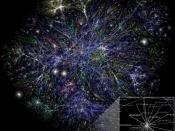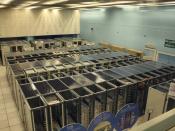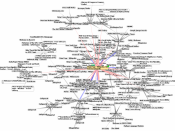Once a small and simple collection of computers run by the Defence Department, is now a massive world wide network of computers, what we call the 'Internet'. The word 'Internet' literally means 'network of networks.' In itself, the Internet is composed of thousands of smaller local networks scattered throughout the globe. It connects roughly 15 million users in more than 50 countries a day. The World Wide Web (WWW) is mostly used on the Internet. The Web refers to a body of information, while the Internet refers to the physical side of the global network containing a large amount of cables and computers.
The Internet is a 'packet-switching' computer network. When a person sends a message over the Internet, it is broken into tiny pieces, called 'packets'. These packets travel over many different routes between the computer that it is being sent from to the computer to which it is being sent to.
Phone lines, either fibre-optics or copper wires ones, carry most of the data packets. Internet computers along the path switch each packet that will take it to its destination, but no two packets need to follow the same path. The Internet is designed so that packets always take the best available route at the time they are travelling. 'Routers' which are boxes of circuit boards and microchips, which do the essential task of directing and redirecting packets along the network. Much smaller boxes of circuit boards and microchips called 'modems' do the task of interpreting between the phone lines and the computer. The packets are all switched into a destination and reassembled by the destination computer. Today's Internet contains enough repetitious and interconnected circuits simply to reroute the data if any portion of the network goes down or gets overloaded.
The packet-switching nature of the Internet gives...


